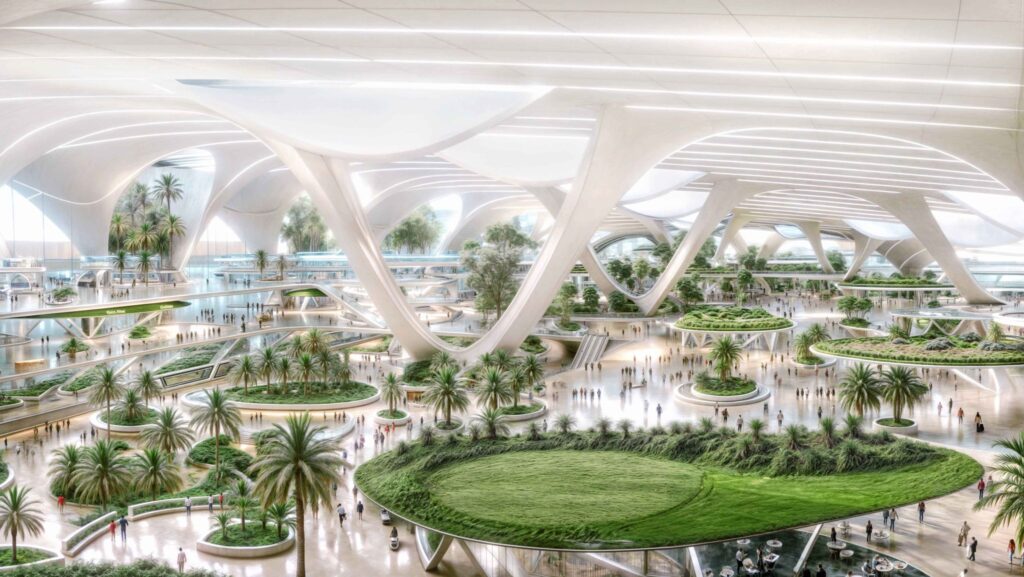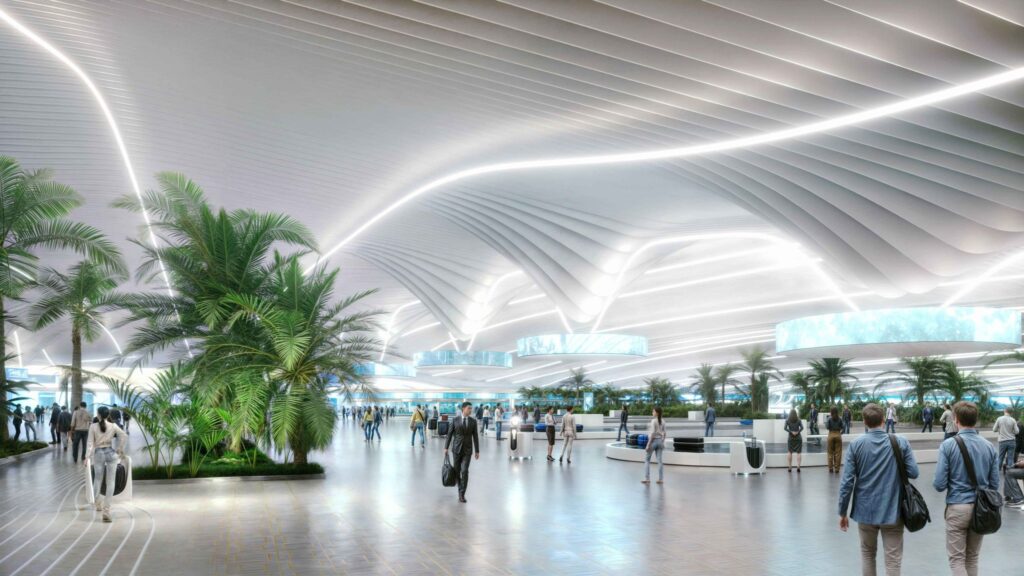On any given day, the terminals of a mega airport pulse with activity: more like a small city than a transit hub. Thousands of workers move in sync as they guide cargo, manage logistics, and welcome travellers. Meanwhile, entire economies hum along in the background. These airports aren’t just infrastructure, they’re transformative.
In 2025, mega airports are emerging as the economic linchpins of a more connected world. With more than a dozen airport megaprojects under construction globally—from San Francisco and Perth to Riyadh and New Delhi—nations are racing to expand capacity and compete for global investment. These hubs are more than gateways for people, though. They’re engines for supporting growth, generating high-skilled jobs, attracting FDI, driving trade, and anchoring regional development.
And they’re being built for the future, backed by carbon-neutral terminals, ESG-driven design, and net-zero aviation targets. Large-scale, modern aviation infrastructure is no longer a nice-to-have, it’s a strategic necessity.
Today we’ll explore how mega airports are reshaping regional economies, and why the most successful projects start with informed strategy.
Mega Airports Around the World

From Asia to the Middle East, and across Europe and North America, mega airports have the potential to reshape the economic geography of entire regions. In the Middle East, Dubai’s Al Maktoum International Airport is on track to become the world’s largest, with a planned capacity reaching 260 million passengers per year and 12 million tonnes of cargo annually. At an estimated cost of $35 billion, the project includes 400 aircraft gates, five parallel runways, and a planned airport city supporting one million residents and global logistics firms.

In China, Beijing Daxing Airport—nicknamed the ‘starfish’—has already catalyzed a logistics and innovation zone, generating billions in investment and new jobs in the surrounding region. Its development directly supports the country’s broader economic targets, including a 5 percent GDP growth rate in 2025, backed by rising urbanization and infrastructure spending.
Europe also continues to push for mega airport development. Expansion plans like Heathrow’s third runway and Frankfurt’s Terminal 3 project are part of a broader effort that could add hundreds of thousands of new flights per year, unlock increased trade, and generate economic benefits estimated in the £100 billion range for the UK alone.
WATCH: Europe is investing over €70 billion in mega airport projects—demonstrating how aviation hubs are evolving into economic development platforms.
These mega airport developments don’t just boost capacity. They generate vast numbers of construction jobs, long-term roles in logistics and aviation services, and broader impacts on GDP. Many are built with sustainability at their core, incorporating electric ground fleets, smart grids, and carbon-neutral terminal design that align with ESG goals.
Together, these global examples show that mega airports are not simply transportation infrastructure but strategic economic infrastructure, shaping the future of regional development.
Economic Impacts: Jobs, Connectivity, and Beyond
According to the Air Transport Action Group, air transport generated approximately 86.5 million jobs globally in 2023—including 11.6 million direct jobs, 20.4 million indirect jobs, 17.2 million induced jobs, and 37.3 million tourism-linked roles. Aviation’s total economic contribution reached $4.1 trillion in 2023 and is projected to nearly double by 2043, reaching $8.5 trillion, equivalent to about 1% of global GDP.
Mega airports amplify these impacts. They spur construction and operational jobs while significantly boosting connectivity, trade value, and investment inflows.
In the U.S., airport modernization is underpinned by the Infrastructure Investment and Jobs Act (IIJA) and related initiatives, with $150 billion earmarked over the coming years for upgrades nationwide. Many major hubs—like New York, Los Angeles, and Dallas/Fort Worth—are undergoing terminal expansions and runway renovations that promise sharp up‑swings in regional activity.
WATCH: From terminal overhauls to sustainability-focused retrofits, America’s $150B infrastructure push is turning airports into engines of regional growth.
Meanwhile, employment trends in U.S. aviation mirror the scale of investment—airlines supported just over 1 million jobs in early 2025, with continued growth in pilot, avionics, and skilled technician roles. The Bureau of Labor Statistics forecasts employment growth of 7% for air transport workers by 2033, outpacing the national average.
Airport activity also impacts trade: commercial aviation represents 33% of global trade by value, despite carrying less than 1% of volume, reflecting the premium nature of air cargo. With increased capacity driven by airport redevelopment, that 33% figure will only rise.
Today’s mega airport projects also lean heavily into sustainability. New builds and revitalizations often feature carbon-neutral terminals, electric ground fleets, and integrated net-zero planning aligned with ESG goals. These aren’t just environmentally forward—they’re economic risk mitigators, appealing to green-conscious investors and resilient infrastructure planners.
For economic developers, the message is clear: mega airports are where connectivity, employment, investment, and innovation coalesce. Their scale turns regional vision into tangible economic reality.
Investment Strategies for Mega Airport Success
Behind every successful mega airport is a blueprint that goes beyond bricks and runways. Strategic airport development demands careful site selection, stakeholder alignment, and long-term investment planning, often underpinned by public-private partnerships and ESG-driven funding models.
Regions that win in this space combine data with diplomacy. They leverage infrastructure intelligence, assess connectivity advantages, and align their airport vision with regional economic development goals. Asia’s airport boom is a leading example: governments have attracted global investment by positioning airports as innovation zones, not just transit hubs.
This is where ResearchFDI comes in.
Our team supports economic developers with data-backed location analysis and FDI strategy consulting. We’ve also launched the ResearchFDI Academy — a groundbreaking online training platform designed to grow the investment attraction expertise of economic development professionals worldwide.
Want to turn global aviation trends into local wins?
Explore the Academy and learn how to develop investment-ready strategies that deliver results.
Or contact our team directly to discuss an investment strategy for your region.
The Future of Mega Airports
Mega airports are no longer just transit points, they’re economic infrastructure, regional anchors, and platforms for long-term investment. In 2025 and beyond, their value lies not only in how many passengers they serve or how many gates they build, but in how effectively they support sustainable growth, high-value job creation, and global competitiveness.
These projects demand more than engineering, they require vision. The most successful airports of the future will be those backed by strategic partnerships, ESG-aligned planning, and data-driven decision-making. Whether it’s attracting global logistics companies, reducing travel friction for high-value sectors, or unlocking billions in foreign direct investment, the ripple effects of a well-planned mega airport extend far beyond the runway.
As nations and regions race to modernize their infrastructure, the stakes have never been higher. The question isn’t if your region should invest in large-scale aviation infrastructure—it’s how.
Can your region harness the full potential of a mega airport?



